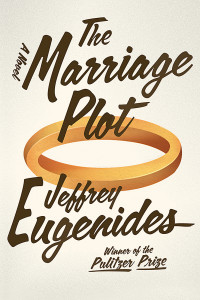
the classic love triangle.
Three Brown University college students, Leonard, Mitchell and Madeleine find themselves in a quixotic love triangle while trying to navigate life after graduation, questions of spirituality and the threat of mental disease in a society that has undergone an extreme transformation—that’s right, the ‘80s.
American Pulitzer Prize-winning novelist Jeffrey Eugenides, who is most known for his first two exceptional works “The Virgin Suicides” (1993) and “Middlesex” (2002), puts a modern spin on the love triangle in his newest New York Times bestseller “The Marriage Plot.”
“The Marriage Plot” opens in 1982 where the reader escapes to the brick- and ivy-clad college town of Brown, R.I. A sense of tradition and pretension perfumes the air as Madeleine, a severely hung-over English student, attempts to get ready for her graduation.
In the midst of collecting herself, Madeleine sorts through her life history and the boys that have played a major role in it; from Leonard, her on and off again boyfriend with a dark secret, to Mitchell, the theology major who never made a move on his obsession with her.
Eugenides uses a slick hand in portraying the pompous atmosphere that accompanies the grandeur of higher education while undermining the institution with a dead on description of the newly emerging punk and feminist scenes from the ‘80s, with, of course, hippie remnants from the ‘60s.
The narrative is told alternately from the point of view of the three star-crossed lovers, which enables Eugenides to inhabit their teenage psyches. He is at once sympathetic with Madeleine’s heartbroken plight and yet subtly mocking of her self-absorbed trifles that stem from a preppy lifestyle and affluent background.
The novel’s greatest strength is in its wit and intimate characterizations, for instance Madeleine’s motivation for studying English is, “She’s become an English major for the purest and dullest of reasons: because she loved to read,” Any college student can identify a part of themselves in Eugenides’ characters and also have a laugh at their own expense through the trio’s struggles.
The idea of the marriage plot itself comes from a thesis written by Madeleine which explains that in Regency and Victorian era literature, all the love stories followed a predictable narrative that ended in marriage.
“The Marriage Plot” is a beautiful yet subtle homage to literature, especially women writers, with many allusions to great authors such as Austen and Eliot, Hemingway and Tolstoy.
The novel’s use of brilliant literary references may lose some readers along the way, however, especially those who have not specialized in 18th century or underground literature.
While knowledge of Eugenides literary allusions is not essential to the enjoyment of the novel and can be overlooked by the reader, it certainly adds to the charm and helps establish its place among other great works.
After graduation from Brown, the novel follows Madeleine and Leonard to Pilgrim Creek at Cape Cod as they try to work through their difficult relationship that is based on the highs and lows of Leonard’s mysterious medical condition, and Mitchell, who retreats to Europe and then India to find salvation when Madeleine spurns his love.
The humor and intricacies of the characters’ inner workings propels the reader through the 400-page read to find out if Madeleine falls prey to the typical marriage plot; but more importantly, Eugenides envelops the reader in a time that was before our own, a time of “quietly hostile” rebellion which our parents laid claim to, a spirit of self-discovery that still resonates within our own college adventures.










